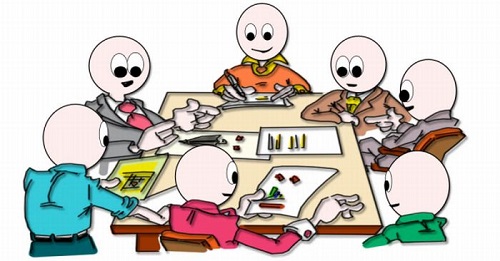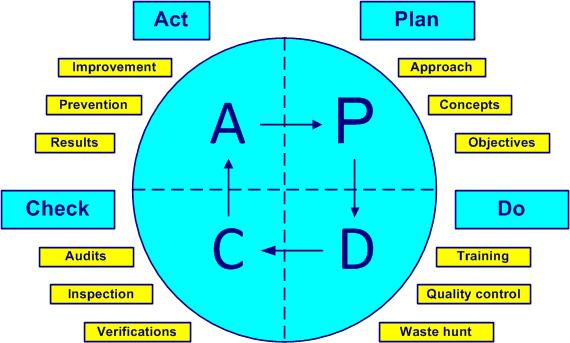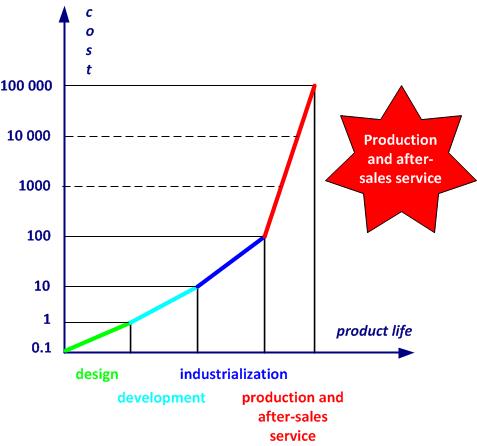4 Principles and concepts .gif)
4.1 Principles
Kaizen principles, 5 S, eliminate waste, standardize

The Kaizen principles are:
- 5 S:
- improve working conditions
- better organize
- less tired
- more safety
- eliminate waste:
- fewer errors (Poka-Yoké)
- quick tool change (SMED)
- less fatigue
- fewer accidents
- standardize:
- really necessary documents
- clear and simple text
- risk prevention (see annex 08)

For these principles to be successfully applied, top management has become aware that:
- staff are the company's most valuable asset and participate in the improvement of all processes
- improvements are made step by step (gradually) in a short time
- each problem can become an opportunity for improvement and not the search for the culprit and their punishment
- working in a multidisciplinary team to solve problems is the rule
- tackling preconceived ideas is not a taboo (example: high quality leads to high costs)
- the question we ask ourselves every day is: how can we improve our performance?
4.2 Concepts
PDCA cycle, next step, quality before results, customer focus, upstream management, data, varaibility, education

The concepts involved in the Kaizen approach include the following ideas.
4.2.1 PDCA cycle
The Deming cycle (figure 4-1) applies to the control of any process. PDCA cycles (Plan, Do, Check, Act) are a universal basis for continual improvementpermanent process allowing the improvement of the global performance of the organization (see also ISO 9000, 3.2.13 and ISO 14 001, 3.2).

Figure 4-1. The Deming cycle
- Plan – define and establish the approach, the concepts, the customers, the processes, the objectives, identify problems
- Do – implement training, control the quality, hunt waste, solve problems
- Check – inspect, analyze, conduct audits, check whether objectives are achieved
- Act - adjust, adapt, improve, react with preventive actions, communicate results, find new improvements (new PDCA)
4.2.2 Next step
Everyone must realize that customers are a fraction of the stakeholders:
- customers
- staff
- environment
- shareholders
- suppliers
Never forget that the downstream processactivities which transform inputs into outputs (see also ISO 9000, 3.4.1) is your customeranyone who receives a product (see also ISO 9000, 3.3.5) because every processactivities which transform inputs into outputs (see also ISO 9000, 3.4.1) has its supplier and its customeranyone who receives a product (see also ISO 9000, 3.3.5). Ensuring quality is:
- not receiving non-conforming products
- not producing non-conforming products and
- not sending non-conforming products
4.2.3 Quality before results
Quality approach takes priority over results. Ensure the necessary time and resources to integrate quality from productany outcome of a process or activity (see also ISO 9000, 3.4.2) design stage. High quality and low costs are not mutually exclusive.
4.2.4 Customer focus
Love your customers more than your products
To guess and understand the requirementsexplicit or implicit need or expectation (see also ISO 9000, 3.1.2) and expectations of the customers (internal and external) and to satisfy them from the point of view of quality, costs and deadlines. To do this, you must become and remain the best in your field and offer your customers services that are even better than their expectations without "over-quality".
The only measure of quality is customer satisfaction
4.2.5 Upstream management
As shown in Figure 4-2, the costs of failures increase on a logarithmic scale in relation to the stage of their discovery. Controlling costs means anticipating problems (managing upstream).

Figure 4-2. The cost of failures versus the life of the product
4.2.6 Rely on data
Forget about intuitions, feelings and impressions. The factual approach means receiving, using and analyzing data objectively, making decisions based on figures. Always doubt the accuracy of the information received and its timeliness.
 Minute of relaxation. Cf. joke “The right place”
Minute of relaxation. Cf. joke “The right place”
4.2.7 Control variability
The best way to get rid of a problem is to solve it
Ask yourself five times the question "Why?" (5 W method), so you can find the root cause of the problem. Operators trained in variability become quality inspectors. This method makes it possible to prevent recurrences. The operators are the most informed of the problems and are the first to realize and react to them.
4.2.8 Education
Practice allows you to consolidate what you have learned in the field. A Chinese proverb says:
Tell me and I'll remember it for an hour. Show me and I'll remember it for a day. Let me do it and I'll remember it forever
The rest of the T 46 Kaizen approach training is accessible on this page.
